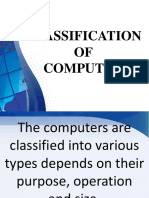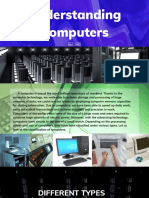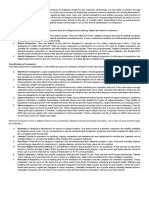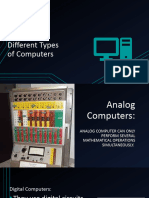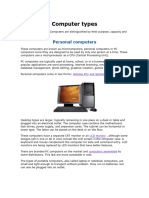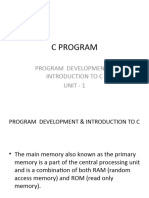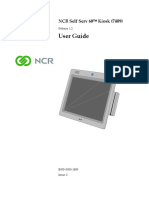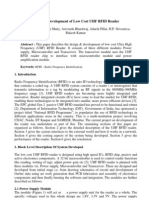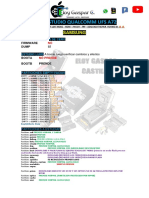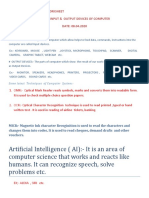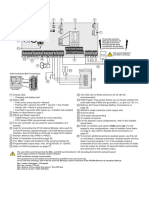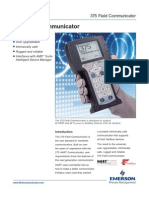Ict 2 Reviewer
Ict 2 Reviewer
Uploaded by
canobasrhonaliediosoCopyright:
Available Formats
Ict 2 Reviewer
Ict 2 Reviewer
Uploaded by
canobasrhonaliediosoOriginal Title
Copyright
Available Formats
Share this document
Did you find this document useful?
Is this content inappropriate?
Copyright:
Available Formats
Ict 2 Reviewer
Ict 2 Reviewer
Uploaded by
canobasrhonaliediosoCopyright:
Available Formats
BASIC – 101: Basic Computer Terms and Definition.
COMPUTER – A computer is a computing device that is similar to an automated abacus that
can execute a program, that is, a sequence of automatic instructions.
DIFFERENT TYPES OF COMPUTERS
ANALOG COMPUTERS – It uses continuous variables for mathematical operations
and utilizes mechanical or electrical energy.
DIGITAL COMPUTERS – They use digital circuits and are designed to operate on two
states, namely bits 0 and 1. They are analogous to states ON and OFF. Data on these
computers is represented as a series of Os and 1s. Digital computers are suitable for
complex computation and have higher processing speeds. They are programmable Digital
computers are either general purpose computers or special purpose ones. Special purpose
computers, as their name suggests, are designed for specific types of data processing
while general purpose computers are meant for general use.
Hybrid Computers - These computers are a combination of both digital and analog
computers, In this type of computers, the digital segments perform process control by
conversion of analog signals to digital ones.
CLASSIFICATION OF COMPUTERS
Mainframe Computers - Large organizations use mainframes for highly critical
applications such as bulk data processing and ERP (Enterprise Resource Planning). Most
of the mainframe computers. Have the capacities to host multiple operating systems and
operate as a number of virtual machines and can substitute for several small servers.
Minicomputers: In terms of size and processing capacity, minicomputers lie in between
mainframes and microcomputers. Minicomputers are also called mid-range systems or
workstations. The term began to be popularly used in the 1960s to refer to relatively
smaller third generation computers.
SERVERS: They are computers designed to provide services to client machines in a
computer network. They have larger storage capacities and powerful processors. Running
on them are programs that serve client requests and allocate resources like memory and
time to client machines. Usually they are very large in size, as they have large processors
and many hard drives. They are designed to be fail-safe and resistant to crash.
SUPERCOMPUTERS: The highly calculation-intensive tasks can be effectively
performed by means of supercomputers. Quantum physics, mechanics, weather
forecasting, molecular theory are best studied by means of supercomputers. Their ability
of parallel processing and their well-designed memory hierarchy give the
supercomputers, large transaction processing powers.
MICROCOMPUTERS: A computer with a microprocessor and its central processing
unit it is known as a microcomputer. They do not occupy space as much as mainframes
do. When supplemented with a keyboard and a mouse, microcomputers can be called
personal computers. A monitor, a keyboard and other similar input output devices,
computer memory in the form of RAM and a power supply unit come packaged in a
microcomputer. These computers can fit on desks or tables and prove to be the best
choice for single-user tasks
Desktops: A desktop is intended to be used on a single location. The spare parts of a
desktop computer are readily available at relatively lower costs. Power consumption is
not as critical as that in laptops. Desktops are widely popular for daily use in the
workplace and households.
Laptops: Similar in operation to desktops, laptop computers are miniaturized and
optimized for mobile use. Laptops run on a single battery or an external adapter that
charges the computer batteries.
Types of Personal Computer
NET BOOKS: They fall in the category of laptops, but are inexpensive and relatively
smaller in size. They had a smaller teature set and lesser capacities in comparison to
regular laptops, at the time they came into the market.
PERSONAL DIGITAL ASSISTANTS (PDAS): It is a handheld computer and
popularly known as a palmtop It has a touch screen and a memory card for storage of
data. PDAs can also be used as portable audio players, web browsers and smart phones.
Most of them can access the Internet by means of Bluetooth or Wi-Fi communication.
TABLET COMPUTERS: Tablets are mobile computers that are very handy to use.
They use the touch
SCREEN TECHNOLOGY. Tablets come with an onscreen keyboard or use a stylus or a
digital pen. Apple’s iPod redefined the class of tablet computers.
WEARABLE COMPUTERS: A record-setting step in the evolution of computers was
the creation of wearable computers. These computers can be worn on the body and are
often used in the study of behavior modeling and human health. Military and health
professionals have incorporated wearable computers into their daily routine, as a part of
such studies. When the users’ hands and sensory organs are engaged in other activities,
wearable computers are of great help in tracking human actions. Wearable computers do
not have to be turned on and off and remain in operation without user intervention.
You might also like
- Sediv 2.3.5.0 Hard Drive Repair Tool Full Version HitDocument3 pagesSediv 2.3.5.0 Hard Drive Repair Tool Full Version Hitluis fernando salazar vargasNo ratings yet
- Migrating From QNX To Embedded LinuxDocument18 pagesMigrating From QNX To Embedded Linuxilie_vlassaNo ratings yet
- Computer Module 3 Lesson 1Document2 pagesComputer Module 3 Lesson 1yuuna yuunaNo ratings yet
- Classification OF ComputerDocument36 pagesClassification OF ComputerJohnry Guzon ColmenaresNo ratings yet
- Kinds of ComputersDocument44 pagesKinds of ComputersGerald TorrezNo ratings yet
- Understanding ComputersDocument23 pagesUnderstanding ComputersMaricor HernandezNo ratings yet
- Understanding ComputerDocument18 pagesUnderstanding ComputerJerson E. RodriguezNo ratings yet
- Understanding ComputerDocument3 pagesUnderstanding ComputerHelner TaghapNo ratings yet
- 2 Understanding ComputerDocument2 pages2 Understanding ComputerAngel Marie TisadoNo ratings yet
- Understanding Computers ICT Grade 9Document21 pagesUnderstanding Computers ICT Grade 9Achilles Charles Grandeza100% (1)
- Types of ComputerDocument31 pagesTypes of Computeraryanvirgo.05No ratings yet
- Lecture 4 - Types of ComputerDocument1 pageLecture 4 - Types of ComputerMeAnnLarrosaNo ratings yet
- What Is A ComputerDocument5 pagesWhat Is A ComputerbrayansegoviaescanoNo ratings yet
- Typesof Computers2Document24 pagesTypesof Computers2Resty BigotaNo ratings yet
- Classification of ComputersDocument28 pagesClassification of ComputershirayamartinsNo ratings yet
- A Computer Is One of The Most Brilliant Inventions of MankindDocument1 pageA Computer Is One of The Most Brilliant Inventions of MankindAmor Lorenzo MirabunaNo ratings yet
- ComputersDocument4 pagesComputersZujajah Gull100% (1)
- Understanding ComputerDocument4 pagesUnderstanding ComputerRoselyn BelgaNo ratings yet
- Different Types of Computers: Hom e Topi Cs Arti Cle SDocument4 pagesDifferent Types of Computers: Hom e Topi Cs Arti Cle SSantosh KumarNo ratings yet
- Different Types of Operating SystemDocument91 pagesDifferent Types of Operating SystemDawin DessertNo ratings yet
- Md. Al Mamun IT Officer CRP-MirpurDocument37 pagesMd. Al Mamun IT Officer CRP-Mirpurmamun183No ratings yet
- Basic Parts of ComputerDocument96 pagesBasic Parts of ComputerDawin DessertNo ratings yet
- Information Sheet 1.2: Types of ComputerDocument23 pagesInformation Sheet 1.2: Types of ComputerBerlin AlcaydeNo ratings yet
- Analog Computers: The Analog Computer Is Almost An Extinct Type of Computer TheseDocument4 pagesAnalog Computers: The Analog Computer Is Almost An Extinct Type of Computer TheseKundaiNo ratings yet
- Understanding ComputerDocument15 pagesUnderstanding ComputerMilagross FabregasNo ratings yet
- Basic 101Document118 pagesBasic 101Yannah LuceroNo ratings yet
- Class 9 Chapter 1 (Part-3) (21-22)Document14 pagesClass 9 Chapter 1 (Part-3) (21-22)anjumjamal8174No ratings yet
- ITB - Unit 1Document18 pagesITB - Unit 1Dr Surya Susan ThomasNo ratings yet
- Types of Computer SystemsDocument17 pagesTypes of Computer Systemstarrant HighNo ratings yet
- Categories of ComputersDocument4 pagesCategories of ComputersEmily Atamelang AttyNo ratings yet
- Week4 5understanding ComputerDocument20 pagesWeek4 5understanding ComputerNefarious MitsiukieNo ratings yet
- STE7 Q1 Week1-2Document3 pagesSTE7 Q1 Week1-2Dexie Joy JaimeNo ratings yet
- Different Types of ComputersDocument27 pagesDifferent Types of ComputersJanine B. JavierNo ratings yet
- Types of ComputersDocument41 pagesTypes of Computerssubramani muthusamyNo ratings yet
- De Nition 1Document14 pagesDe Nition 1brian mburuNo ratings yet
- Occupational Health and Safety Understanding ComputerDocument2 pagesOccupational Health and Safety Understanding ComputerRegina Fe EmpasNo ratings yet
- Different Types of ComputersDocument87 pagesDifferent Types of Computersmike22No ratings yet
- 1Document4 pages1Lata SharmaNo ratings yet
- Types of ComputersDocument5 pagesTypes of ComputersRhea Tupan PradoNo ratings yet
- FINAL Lesson 1 Plan and Prepare For InstallationDocument117 pagesFINAL Lesson 1 Plan and Prepare For Installationcalatravamarcuslean8No ratings yet
- Computer Studies Notes-1Document27 pagesComputer Studies Notes-1calebkimanzi254No ratings yet
- Personal ComputerDocument23 pagesPersonal ComputerJERWIN HONRADONo ratings yet
- Computer TypesDocument25 pagesComputer TypesScribdTranslationsNo ratings yet
- Fundamental of Computer Input/ Output, Processing and Memory DeviceDocument12 pagesFundamental of Computer Input/ Output, Processing and Memory Devicenandkishor joshiNo ratings yet
- Wa0013Document12 pagesWa0013Afaq AhmadNo ratings yet
- HandoutDocument9 pagesHandoutjarelleNo ratings yet
- Information Technology Unit 2Document10 pagesInformation Technology Unit 2Nandhini VirgoNo ratings yet
- ITandBUSSINES III BCOM - Unit -IDocument18 pagesITandBUSSINES III BCOM - Unit -IAnitha SakthivelNo ratings yet
- Types of ComputersDocument77 pagesTypes of ComputersRojen SabileNo ratings yet
- Computer Application in BusinessDocument64 pagesComputer Application in BusinessFatima Ali100% (2)
- Programming Languages Unit - IDocument88 pagesProgramming Languages Unit - IVinoth Kumar MNo ratings yet
- The Defferent Types of Computers and ClassificationsDocument9 pagesThe Defferent Types of Computers and ClassificationsKrishza Jane NacionalesNo ratings yet
- 316 Types of ComputersDocument44 pages316 Types of Computersayola0412No ratings yet
- Classification of ComputersDocument3 pagesClassification of Computerselvisokinda746No ratings yet
- Types of Computer SystemsDocument23 pagesTypes of Computer SystemsVinoth Raj100% (3)
- Computers Category: Classes of ComputersDocument4 pagesComputers Category: Classes of ComputersArul RajNo ratings yet
- Classifications of Computers: 1. According To PurposeDocument2 pagesClassifications of Computers: 1. According To PurposeRosen LPNo ratings yet
- Classification of Digital ComputersDocument2 pagesClassification of Digital ComputersSreenath SukumaranNo ratings yet
- Classification of ComputersDocument16 pagesClassification of ComputersTEENo ratings yet
- Different Types of ComputerDocument3 pagesDifferent Types of Computerrotsacreijav666666No ratings yet
- Lecture 2 NotesDocument6 pagesLecture 2 Noteskaderomike19No ratings yet
- An Introduction to Computers and Internet - A Practical PresentationFrom EverandAn Introduction to Computers and Internet - A Practical PresentationNo ratings yet
- Microsystem Simatic S7-200: One Hourprimer 7/99Document55 pagesMicrosystem Simatic S7-200: One Hourprimer 7/99Bruno PalašekNo ratings yet
- NCR SelfServ 60 7409 User GuideDocument108 pagesNCR SelfServ 60 7409 User Guidejesus0% (1)
- Motorola Driver LogDocument5 pagesMotorola Driver Lognice_love_denis2006No ratings yet
- 28-01-2016-19-07-OpenScape XpertDocument4 pages28-01-2016-19-07-OpenScape XpertDavaadagva AltansarnaiNo ratings yet
- Lte5731 - TCP Service DifferentiationDocument8 pagesLte5731 - TCP Service DifferentiationBA AbdourahmaneNo ratings yet
- MicroBeta Instrument Manual BsDocument322 pagesMicroBeta Instrument Manual Bsnabil160874No ratings yet
- Paper UHF RFID ReaderDocument8 pagesPaper UHF RFID Readerwaqar_malikNo ratings yet
- Esp32-S2 Datasheet enDocument51 pagesEsp32-S2 Datasheet enJYK STONENo ratings yet
- Spesifikasi Audixi A+Document1 pageSpesifikasi Audixi A+mas agung chandraNo ratings yet
- Studuino Tutorial Block 1Document66 pagesStuduino Tutorial Block 1Faviola Alarcón CornejoNo ratings yet
- Hoja de Estudio Samsung Ufs A72Document7 pagesHoja de Estudio Samsung Ufs A72Gonzalo CoaquiraNo ratings yet
- How To Truly Install Android x86 in VESA ModeDocument1 pageHow To Truly Install Android x86 in VESA ModeMarcel PiersonNo ratings yet
- Lenovo HCLDocument14 pagesLenovo HCLIsrael AlvesNo ratings yet
- Manual On Siemens Software and Cable Configurations PDFDocument7 pagesManual On Siemens Software and Cable Configurations PDFjaimeasisaNo ratings yet
- PT. METAKOM CPRANATA Mechanical Electrical Engineers 416805906.xls/ELEKTRONIKDocument2 pagesPT. METAKOM CPRANATA Mechanical Electrical Engineers 416805906.xls/ELEKTRONIKDani AhmadNo ratings yet
- MacWorld 8404 April 1984 PremierDocument148 pagesMacWorld 8404 April 1984 PremierIvan BuhaNo ratings yet
- Acadnet 2010: Multiple-Choice Single-Answer QuestionsDocument5 pagesAcadnet 2010: Multiple-Choice Single-Answer QuestionsbambamNo ratings yet
- Class V Computer WorksheetDocument3 pagesClass V Computer WorksheetSUNIL GAUTAMNo ratings yet
- Team Elite U DIMM DDR3 EDMDocument2 pagesTeam Elite U DIMM DDR3 EDMHenry LanzaNo ratings yet
- 22MP58VQ-P / 24MP58VQ-P / 27MP58VQ-PDocument1 page22MP58VQ-P / 24MP58VQ-P / 27MP58VQ-PAnub RaNo ratings yet
- WWW Techquila Co in TSMC First 7nm Octa Core A72 Chip Is A Performance BeastDocument4 pagesWWW Techquila Co in TSMC First 7nm Octa Core A72 Chip Is A Performance BeastRoshan RajuNo ratings yet
- New - IBM LTO-8 Firmware Version Q3A0 (FH) and Q3A1 (HH) Release NotesDocument2 pagesNew - IBM LTO-8 Firmware Version Q3A0 (FH) and Q3A1 (HH) Release NotesnebacarNo ratings yet
- X86 Assembly/Print VersionDocument103 pagesX86 Assembly/Print VersionSriram ShanmugaNo ratings yet
- ARM7 TDMI Manual Pt3Document46 pagesARM7 TDMI Manual Pt3Deepanshu UpadhyayNo ratings yet
- #SP - Συνδεσμολογία sp7000Document1 page#SP - Συνδεσμολογία sp7000vardkakNo ratings yet
- 169-Hart 375 Data SheetDocument8 pages169-Hart 375 Data SheetdovletgeldiNo ratings yet
- Software Defined Storage For DummiesDocument75 pagesSoftware Defined Storage For DummiesWael Mohesn100% (1)
- Module 1 E CommerceDocument33 pagesModule 1 E CommerceJeoven Izekiel RedeliciaNo ratings yet



